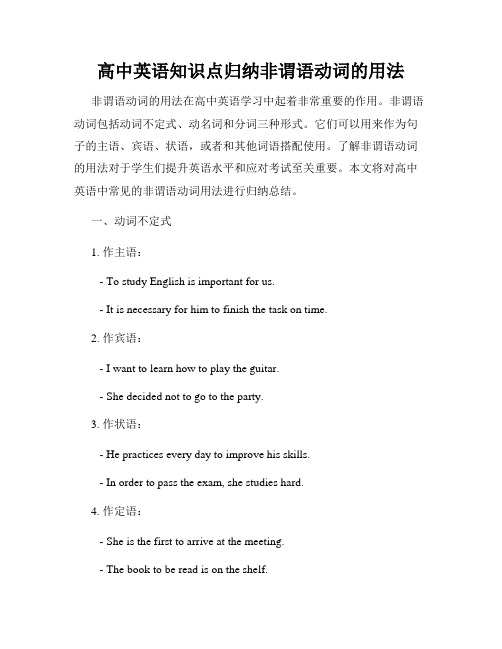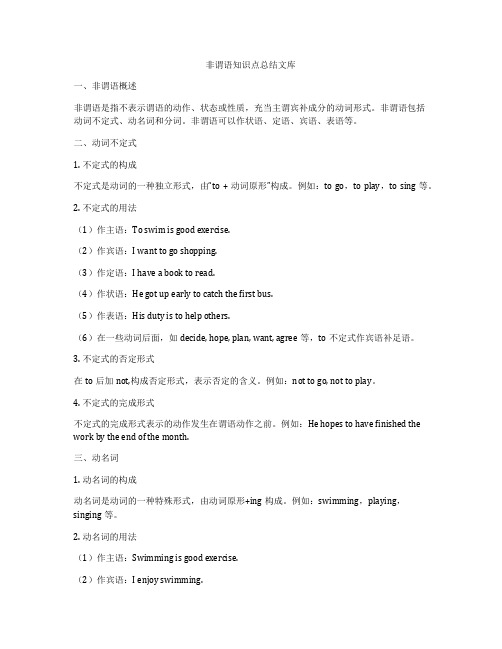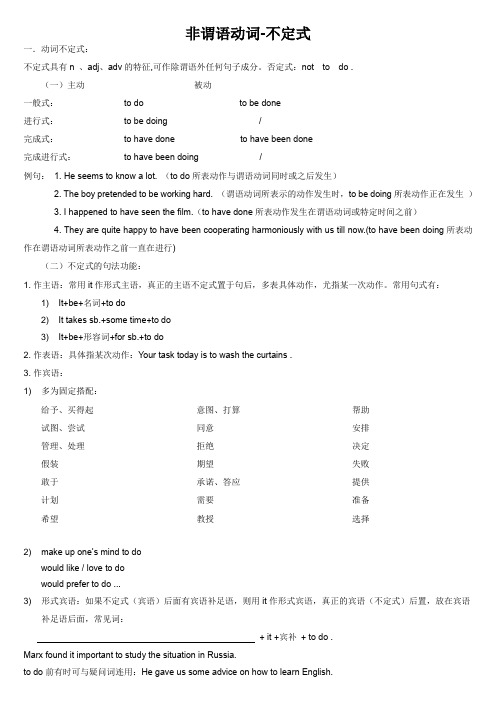非谓语动词-动词不定式知识点总结
高中英语知识点归纳非谓语动词的用法

高中英语知识点归纳非谓语动词的用法非谓语动词的用法在高中英语学习中起着非常重要的作用。
非谓语动词包括动词不定式、动名词和分词三种形式。
它们可以用来作为句子的主语、宾语、状语,或者和其他词语搭配使用。
了解非谓语动词的用法对于学生们提升英语水平和应对考试至关重要。
本文将对高中英语中常见的非谓语动词用法进行归纳总结。
一、动词不定式1. 作主语:- To study English is important for us.- It is necessary for him to finish the task on time.2. 作宾语:- I want to learn how to play the guitar.- She decided not to go to the party.3. 作状语:- He practices every day to improve his skills.- In order to pass the exam, she studies hard.4. 作定语:- She is the first to arrive at the meeting.- The book to be read is on the shelf.5. 作表语:- My dream is to become a doctor.- The important thing is to keep calm.6. 作补语:- I need you to help me with the project.- He made her laugh.二、动名词1. 作主语:- Learning a new language requires patience. - Swimming is good for health.2. 作宾语:- I enjoy reading books in my free time.- She admitted stealing the money.3. 作状语:- He left without saying goodbye.- She passed the test by studying hard.4. 作定语:- The running water is very clean.- I heard someone singing in the distance.5. 作表语:- His favorite hobby is playing basketball.- The key to success is hard work.6. 作补语:- I started regretting not studying harder.- They kept us waiting for hours.三、分词1. 现在分词(-ing形式):- The running boy is my brother.- She saw a smoking man on the street.2. 过去分词(-ed/-en形式):- The broken vase needs to be replaced.- They were excited by the surprising news.3. 作状语:- Enjoying the beautiful scenery, we went for a walk.- Being well-prepared, she felt confident in the interview.4. 作定语:- The lost cat was found by its owner.- The written report should be handed in by tomorrow.5. 作补语:- She was surprised to find her car stolen.- I felt exhausted after running for an hour.综上所述,高中英语中的非谓语动词有动词不定式、动名词和分词三种形式,它们在句子中能够充当不同的成分,起到丰富语言表达和提高语言准确性的作用。
非谓语知识点总结文库

非谓语知识点总结文库一、非谓语概述非谓语是指不表示谓语的动作、状态或性质,充当主谓宾补成分的动词形式。
非谓语包括动词不定式、动名词和分词。
非谓语可以作状语、定语、宾语、表语等。
二、动词不定式1. 不定式的构成不定式是动词的一种独立形式,由“to + 动词原形”构成。
例如:to go,to play,to sing等。
2. 不定式的用法(1)作主语:To swim is good exercise.(2)作宾语:I want to go shopping.(3)作定语:I have a book to read.(4)作状语:He got up early to catch the first bus.(5)作表语:His duty is to help others.(6)在一些动词后面,如decide, hope, plan, want, agree等,to不定式作宾语补足语。
3. 不定式的否定形式在to后加not,构成否定形式,表示否定的含义。
例如:not to go, not to play。
4. 不定式的完成形式不定式的完成形式表示的动作发生在谓语动作之前。
例如:He hopes to have finished the work by the end of the month.三、动名词1. 动名词的构成动名词是动词的一种特殊形式,由动词原形+ing构成。
例如:swimming,playing,singing等。
2. 动名词的用法(1)作主语:Swimming is good exercise.(2)作宾语:I enjoy swimming.(3)作定语:I have a swimming pool.(4)作状语:She left after finishing her homework.3. 动名词的否定形式在动名词前加not来构成否定形式。
例如:not swimming, not playing。
非谓语动词总结知识点

非谓语动词总结知识点一、动词不定式(Infinitive)动词不定式由“to + 动词原形”构成。
动词不定式在句子中可以作多种成分,具有名词的性质。
下面是动词不定式的主要用法:1. 作主语:To travel around the world is my dream.2. 作宾语:I want to study English.3. 作定语:The best way to learn English is to practice speaking.4. 作表语:My goal is to improve my English.5. 作状语:He goes to the library to study every day.当动词不定式作为宾语补足语时,它可以由动词原形构成(Bare Infinitive)。
例如:I saw him draw a picture yesterday. (我昨天看到他画了一幅画。
)二、动名词(Gerund)动名词是由动词的现在分词形式加上动词-ing构成的。
动名词在句子中可以作多种成分,具有名词的性质。
下面是动名词的主要用法:1. 作主语:Reading is my hobby.2. 作宾语:I enjoy swimming in the ocean.3. 作定语:I like watching movies.4. 作表语:His favorite activity is playing basketball.5. 作状语:He left without saying goodbye.动名词与不定式的区别在于,动名词具有名词的性质,而动词不定式具有动词的性质。
例如:I like swimming. (我喜欢游泳。
)I like to swim. (我喜欢游泳。
)动名词与动词不定式作宾语时,有时可以根据动词选择使用不定式还是动名词。
例如:I stopped smoking. (我戒烟了。
高中非谓语动词知识点汇总

高中非谓语动词知识点汇总非谓语动词是指动词的非谓语形式,包括不定式、动名词和分词。
它们在句子中常常作状语、宾语、表语等成分,起到修饰或补充说明的作用。
高中阶段,学生需要掌握非谓语动词的形式、用法及常见搭配,并能够正确运用于句子中。
下面将对高中非谓语动词的知识点进行详细汇总。
1. 不定式(Infinitive)不定式是动词的一种形式,具有名词、形容词和副词的特点。
不定式的基本形式是“to + 动词原形”,在句中可以作主语、表语、宾语、宾语补足语、定语和状语等。
【基本形式】不定式的基本形式是“to + 动词原形”,如:to eat(吃)、to go (去)等。
【作主语】不定式可以作主语,如:- To study is essential for students.(学生学习是必要的)【作表语】不定式可以作表语,如:- His dream is to become a doctor.(他的梦想是成为一名医生)【作宾语】不定式可以作及物动词的宾语,如:- I want to learn English.(我想学英语)【作宾语补足语】不定式可以作及物动词的宾语补足语,如:- They made him apologize to the teacher.(他们让他向老师道歉)【作定语】不定式可以作定语,修饰名词,如:- She has a lot of books to read.(她有很多书要读)【作状语】不定式可以作状语,修饰动词、形容词、副词或整个句子,如:- We work hard to achieve our goals.(我们努力工作以实现我们的目标)2. 动名词(Gerund)动名词是动词的一种形式,具有名词的特点,它的形式是动词的ing形式。
动名词可以作主语、表语、宾语、宾语补足语、定语和状语等。
【基本形式】动名词的基本形式是动词的ing形式,如:- Eating(吃), sleeping(睡觉),running(跑步)等。
非谓语动词-不定式

非谓语动词-不定式一.动词不定式:不定式具有n 、adj、adv的特征,可作除谓语外任何句子成分。
否定式:not to do .(一)主动被动一般式:to do to be done进行式:to be doing /完成式:to have done to have been done完成进行式:to have been doing /例句:1. He seems to know a lot. (to do所表动作与谓语动词同时或之后发生)2. The boy pretended to be working hard. (谓语动词所表示的动作发生时,to be doing所表动作正在发生)3. I happened to have seen the film.(to have done所表动作发生在谓语动词或特定时间之前)4. They are quite happy to have been cooperating harmoniously with us till now.(to have been doing所表动作在谓语动词所表动作之前一直在进行)(二)不定式的句法功能:1. 作主语:常用it作形式主语,真正的主语不定式置于句后,多表具体动作,尤指某一次动作。
常用句式有:1) It+be+名词+to do2) It takes sb.+some time+to do3) It+be+形容词+for sb.+to do2. 作表语:具体指某次动作:Your task today is to wash the curtains .3. 作宾语:1) 多为固定搭配:给予、买得起试图、尝试管理、处理假装敢于计划希望意图、打算同意拒绝期望承诺、答应需要教授帮助安排决定失败提供准备选择2) make up one’s mind to dowould like / love to dowould prefer to do ...3) 形式宾语:如果不定式(宾语)后面有宾语补足语,则用it作形式宾语,真正的宾语(不定式)后置,放在宾语补足语后面,常见词:+ it +宾补+ to do .Marx found it important to study the situation in Russia.to do前有时可与疑问词连用:He gave us some advice on how to learn English.4) 句型:过去常做不得不做应该做愿意做准备、愿意做be sure / glad / happy / afraid +to do be sorry / anxious / eager +to do5) 省略to 的句型:为什么不做?不能做只能做最好做宁愿做而不做4. 作补语:1) 在复合宾语中,动词不定式可充当宾语补足语,如下动词常跟这种复合宾语:want wishasktellorder beg permit help advise persuade allowpreparecauseforcecall onwait forinviteencourageexpectforbidgetintendlikelovepreferremindrequireteachwarndepend on此外,介词有时也与这种复合宾语连用,如:With a lot of work to do, he didn't go to the cinema.2) 有些动词如make, let, see, watch, hear, feel, have等与不带有to的不定式连用,但改为被动语态时,不定式要加to (主动省略to 被动还原to):I saw him cross the road.He was seen to cross the road.※五看:三让:二听:一感觉:3) 作主语补足语的句型:said reportedsb + be believed considered + to be doneknown found to have been donesupposed thoughtIt is said that he has gone abroad .= He is said to have gone abroad .He was later discovered to have been a spy.4)thinkconsiderbelievesupposefeel ...+ to be 作宾语补足语或主语补足语findimagineproveappointjudge 例:People considered him to be a great leader .He imagines himself to be an able man .5. 作定语:1) 若不定式所修饰词是不定式的地点、工具,不定式后要有相应介词:He didn’t have a house to live in . 若修饰的词为:time、way、place,不定式后省略介词: He didn’t have place to live .2) 若不定式作定语与所修饰词形成被动关系(动宾关系),可用to do 也可用to be done :Have you got anything to send ? (执行者为句子主语)to be sent ? (执行者是其他人)3) 用不定式作定语的情况:①表将来:The car to be bought is for his sister .②修饰被序数词、最高级或no ,all ,any 限定的中心词且为主动关系:He was the best man to do the job .③用来修饰抽象名词:能力机会主意事实借口承诺答案回复企图信仰方式理由时刻时光☆某些名词的同根词常跟to do ,因而也跟to do ,如:计划提议决定拒绝失败警告焦虑渴望愿望准备就绪例:我没有去观光的机会我不相信他会来访的承诺他没有去那里的计划他没有计划去那里6.作状语:1) 目的状语:He worked day and night to get the money. 若强调目的性,也可加in order to (可在句首)/ so as to(只在句中),此两结构在剧中时,不用都好隔开。
非谓语动词-动词不定式知识点总结

非谓语动词(the Non-Finite Verbs)---动词不定式知识总结非谓语动词是指在句子中不充当谓语的动词,主要包括不定式、动名词和分词(现在分词和过去分词),即动词的非谓语形式。
非谓语动词除了不能独立作谓语外,可以承担句子的其他成分。
动词不定式既具有动词的一些特征,又具有名词、形容词和副词的句法功能。
Ⅰ、不定式的构成及变形:动词不定式是由不定式符号to+动词原形构成,在某些情况下to也可省略。
1. 不定式的一般式不定式的一般式表示的动作通常与谓语的动作同时或几乎同时发生,或是在它之后发生。
He appears to be very happy.(同时发生)To catch the train, we'd better hurry to the station by taxi.(to catch the train发生在hurry to the station之后)2. 不定式的进行式不定式的进行式表示正在进行的或与谓语动词同时发生的动作。
It happened to be raining when I got there.3. 不定式的完成式不定式的完成式表示的动作在谓语表示的动作之前发生。
I'm sorry to have lost your key.4. 不定式的完成进行式不定式的完成进行式表示的动作在谓语之前发生并且一直进行着。
He was said to have been living in London for twenty years.不定式的时态意义:He is said to be studying abroad.(不定式的进行式表示动作正在进行)He is said to have studied abroad.(不定式的完成式表示动作已经结束)5. 不定式的被动形式当不定式逻辑上的主语是这个不定式表示的动作的承受者时,不定式一般要用被动形式。
不定式的被动形式根据其与谓语动作发生的先后关系,有一般式和完成时两种。
非谓语法知识点总结
非谓语法知识点总结一、不定式1.不定式的构成不定式是动词的非限定性形式,它的构成通常是“to + 动词原形”。
例如:to go, to eat, to study等。
2.不定式的用法a.不定式可以在句子中作主语,例如:To learn a new language is not easy.b.不定式可以在句子中作宾语,例如:I want to go shopping.c.不定式可以在句子中作定语,例如:This is the book to read.d.不定式可以在句子中作状语,例如:I came here to see you.3.不定式的时态不定式的时态没有人称和数的变化,它是动词的原形,不受动词时态和语态的影响,例如:I like to read books. She wants to go shopping.4.不定式的被动语态不定式的被动语态构成为“to be + 动词过去分词”,例如:The room needs to be cleaned.5.不定式的完成时不定式的完成时形式为“to have + 过去分词”,例如:I am glad to have met you.6.不定式的否定形式不定式的否定形式可以通过在to前加not构成,“not to + 动词原形”,例如:I decided not to go.7.不定式的省略如果一个句子中有两个及以上的不定式,且它们的to是一样的,那么这个to就可以省略掉,例如:I want to go and see the movie.(I want to go and to see the movie.)二、动名词1.动名词的构成动名词是动词的一种特殊形式,名词化的动词,它的构成形式是动词原形+ing,例如:reading, writing, swimming等。
2.动名词的用法a.动名词可以在句子中作主语,例如:Swimming is my favorite sport.b.动名词可以在句子中作宾语,例如:I enjoy reading books.c.动名词可以在句子中作定语,例如:I saw a man running in the street.d.动名词可以在句子中作状语,例如:She left without saying goodbye.3.动名词的时态动名词的时态也是不受动词的时态和语态的限制,例如:I like swimming. She has been reading for an hour.4.动名词的被动语态动名词的被动语态构成为“being + 过去分词”,例如:Being loved by everyone makes her happy.5.动名词的否定形式动名词的否定形式是在-ing后面加not,例如:He avoids talking to her.6.动名词的所有格形式动名词的所有格形式是在-ing后面加‘s,例如:I don’t like his swimming in the pool.7.动名词与不定式的区别动名词和不定式在句子中有时候可以互换,但它们表示的含义和用法是有区别的。
非谓语动词考点总结归纳
非谓语动词考点总结归纳非谓语动词是英语中的一种重要语法形式,一般指动词的非时态形式。
常见的非谓语动词包括动词不定式(to + 动词原形)、动名词(-ing 形式)和分词(过去分词和现在分词)。
这些形式常常用来作定语、状语或宾语等成分,能够丰富语言表达,增强文学效果,因此在英语学习和考试中尤为重要。
下面我们就来归纳总结一下非谓语动词的考点和应用。
1.动词不定式作主语:to + 动词原形例如:To know her is to love her.(了解她就爱上她。
)To err is human. (犯错误是人之常情。
)To succeed, we must work harder.(要成功,我们必须更加努力。
)动词不定式作主语时,有时需要加上it作形式主语,而to + 动词原形作真正的主语。
It’s important to keep a balanced diet.(保持平衡饮食很重要。
)I want to go to the cinema tonight.(我今晚想去看电影。
)She decided to study abroad.(她决定出国留学。
)I asked him to help me with my homework.(我让他帮我做作业。
)动词不定式作宾语时,常常由动词后面的名词、代词、形容词等构成宾语补足语,表示宾语的具体内容或目的。
We need someone to help us with the project.(我们需要个人协助我们完成这个项目。
)动词不定式作定语时,表示被修饰名词的用途或目的。
My plan to visit China next year has been postponed.(我明年计划去中国的计划已经被推迟了。
)动词不定式作状语时,表示动作的目的、原因、结果、条件、方式等。
Mary gets up early to jog in the park.(Mary早起在公园里慢跑。
高中英语知识点归纳非谓语动词的特殊形式和用法
高中英语知识点归纳非谓语动词的特殊形式和用法非谓语动词是英语中的一种特殊用法,不具备人称和数的变化,不可作谓语,常以动词形式出现在句子中。
本文将针对高中英语中非谓语动词的特殊形式和用法进行归纳总结。
一、非谓语动词的特殊形式1. 动词不定式(Infinitive)动词不定式以to+动词原形构成,可以作主语、宾语、表语、定语或状语。
例如:To learn a foreign language is important.(作主语)2. 现在分词(Present Participle)现在分词以-ing结尾,可以作定语、表语或状语。
例如:The girl sitting next to me is my sister.(作定语)3. 过去分词(Past Participle)过去分词可以作定语、表语、状语或动词的宾语补足语。
例如:The broken vase belongs to my grandmother.(作定语)二、非谓语动词的用法1. 不定式作主语示例:To make a decision is not easy.2. 不定式作宾语示例:I want to visit Paris next summer.3. 不定式作表语示例:His dream is to become a doctor.4. 不定式作定语示例:He needs a book to read in his spare time.5. 不定式作状语示例:I went to the library to study.6. 现在分词作定语示例:The students sitting at the back of the classroom are talking.7. 现在分词作表语示例:The book is interesting.8. 现在分词作状语示例:Crying loudly, the baby woke up the whole neighborhood.9. 过去分词作定语示例:The broken glass cut my finger.10. 过去分词作表语示例:I am excited about the news.11. 过去分词作状语示例:Having finished his homework, he went out to play basketball.以上便是高中英语中非谓语动词的特殊形式和用法的归纳总结。
初中知识点归纳非谓语动词的分类与形式
初中知识点归纳非谓语动词的分类与形式非谓语动词是指在句子中作状语、定语或补语,不具备时态和人称的动词形式。
初中阶段涉及的非谓语动词主要包括动词不定式、动名词和分词。
本文将对非谓语动词的分类与形式进行归纳。
一、动词不定式(infinitive)动词不定式是非谓语动词中最常见的形式之一,它由“to + 动词原形”构成,具有名词和动词的双重性质。
1. 主动形式主动形式的动词不定式可以作为句子的主语、宾语、表语、宾语补足语等。
例如:- To learn English well is my goal. (主语)- He likes to play football. (宾语)- Her dream is to become a doctor. (表语)- They want to buy a new car. (宾语补足语)2. 被动形式被动形式的动词不定式表示动作的承受者,常用于被动语态中。
它由“to be + 过去分词”构成。
例如:- The job needs to be done quickly. (承受者为the job)- He hopes to be invited to the party. (承受者为he)3. 否定形式否定形式的动词不定式在“to”之后添加“not”,表示否定的意义。
例如:- I decided not to go to the party. (否定形式作为不定式的一部分)二、动名词(gerund)动名词是以动词ing形式充当名词的一种形式,具有名词的特点,可以作为主语、宾语、表语、定语、宾语补足语等。
1. 作主语动名词作为句子的主语时,常用单数形式。
例如:- Reading is my favorite hobby.- Swimming is good for health.2. 作宾语动名词作为某些动词的宾语,表示动作的客体。
例如:- I enjoy playing basketball.- He avoids eating junk food.3. 作表语动名词作为表语时,通常表示状态或特征。
- 1、下载文档前请自行甄别文档内容的完整性,平台不提供额外的编辑、内容补充、找答案等附加服务。
- 2、"仅部分预览"的文档,不可在线预览部分如存在完整性等问题,可反馈申请退款(可完整预览的文档不适用该条件!)。
- 3、如文档侵犯您的权益,请联系客服反馈,我们会尽快为您处理(人工客服工作时间:9:00-18:30)。
非谓语动词(the Non-Finite Verbs)---动词不定式知识总结非谓语动词是指在句子中不充当谓语的动词,主要包括不定式、动名词和分词(现在分词和过去分词),即动词的非谓语形式。
非谓语动词除了不能独立作谓语外,可以承担句子的其他成分。
动词不定式既具有动词的一些特征,又具有名词、形容词和副词的句法功能。
Ⅰ、不定式的构成及变形:动词不定式是由不定式符号to+动词原形构成,在某些情况下to也可省略。
1. 不定式的一般式不定式的一般式表示的动作通常与谓语的动作同时或几乎同时发生,或是在它之后发生。
He appears to be very happy.(同时发生)To catch the train, we'd better hurry to the station by taxi.(to catch the train发生在hurry to the station之后)2. 不定式的进行式不定式的进行式表示正在进行的或与谓语动词同时发生的动作。
It happened to be raining when I got there.3. 不定式的完成式不定式的完成式表示的动作在谓语表示的动作之前发生。
I'm sorry to have lost your key.4. 不定式的完成进行式不定式的完成进行式表示的动作在谓语之前发生并且一直进行着。
He was said to have been living in London for twenty years.不定式的时态意义:He is said to be studying abroad.(不定式的进行式表示动作正在进行)He is said to have studied abroad.(不定式的完成式表示动作已经结束)5. 不定式的被动形式当不定式逻辑上的主语是这个不定式表示的动作的承受者时,不定式一般要用被动形式。
不定式的被动形式根据其与谓语动作发生的先后关系,有一般式和完成时两种。
一般式to be doneThese are the books to be given out to the students.完成式to have been doneThe novel is said to have been translated into many languages.6. 不定式的否定形式不定式的否定形式由not或never加不定式构成。
We decided not to go out because of the bad weather. 由于天气不好,我们决定不出去。
注意:谓语动词的否定和不定式的否定不同的意义I did not promise to wake him up. 我没有答应叫醒他。
I promised not to wake him up. 我答应了不叫醒他。
Ⅱ、不定式句法功能不定式可以作句子的主语、宾语、宾语补足语、表语、定语、状语等成分。
1.作主语To hear from you is nice.To be a good teacher is not easy.不定式作主语时,为了保持句子的平衡,往往以it作形式主语,而不定式置于谓语动词后。
It’s nice to hear from you.It’s not easy to be a good teacher.2.作宾语通常用于afford, agree, aim, arrange, ask, attempt, choose, continue, dare, decide, demand, desire, determine, expect, fail, hate, help, hesitate, hope, intend, learn, long, love, manage, mean, need, offer, plan, prefer, prepare, pretend, promise, prove, refuse, seek, threaten, trouble, wait, want, wish等动词后面。
I forgot to lock the door.Please remember to write to me.记忆口诀:三个希望两答应(hope,wish,want,agree,promise)一个要求莫拒绝(demand,refuse)设法学会做决定(manage,decide)不要假装在选择(pretend,choose)3.作表语My job is to pick up letters.He seemed to have heard nothing.4.作定语在the first, the second, the third, the last等之后通常接不定式作定语。
作定语时须放在被修饰的名词之后:He is always the first one to get up.I have a few words to say on this question.主动形式表被动含义:I have a book to read.It is easy to read.Have you anything to send?比较:Have you anything to be sent?She is the last to come.He is looking for a room to live in.There is nothing to worry about.5.作宾补通常用于advise, allow, ask, beg, cause, challenge, convince, enable, encourage, expect, forbid, force, instruct, invite, order, permit, persuade, recommend, remind, request, require, teach, tell, train, urge, want, warn等词后。
He ordered her to leave at once.He was forced to obey his mother’s order.6.作状语不定式作状语时通常表示目的,不定式用作目的状语有两个可能的位置,一是在句首,二是在句末。
一般说来,用于句首属于强调性用法,即强调动词的目的。
也可用于“be adj. to do”结构中作原因状语。
He got up early to catch the first bus.To finish the task on time, we have to work hard.I’m happy to hear the news.I’m surprised to see him here.only to...往往表示“意想不到”的结果;never to...可以接后续的结果。
so...as to..., such... as to..., enough to..., only to...以及too...to...等结构中的不定式也表结果:Her father disappeared, never to be heard again.I went to the bank only to find it was closed.Ⅲ、不定式和现在分词作状语的区别1.作目的状语。
不定式作目的状语,带有很强的目的性,有时可以把(in order) to do置于句首。
而现在分词作目的状语时,目的和伴随兼而有之。
多放于句末,与主句用逗号隔开。
(In order) to ensure success, we must make a complete and through plan.You should keep it a secret, trying to protect the plan.2.作结果状语。
不定式作结果状语表示意外的结果。
现在分词作状语表示自然的结果。
He returned home many years later, only to find that everything had changed.(意外的结果)It rained heavily last night, causing the river to rise.(自然的结果)Ⅳ、作独立成分to be honest, to begin with, to start with, to tell you the truth, to make a long story shortTo tell you the truth, I told a lie.To begin/start with, let’s sing a song.To make a long story short, he succeeded in passing the exam.Ⅴ、不定式特殊用法1.用it作形式主语动词不定式作主语时,如果主语太长,通常用it作形式主语,将真正的主语——动词不定式后置。
For us to learn English well is necessary.→It is necessary for us to learn English well.动词不定式作主语时,如果将句子变为疑问句,应使用it作形式主语。
To walk to the station takes twenty minutes.→Does it take twenty minutes to walk to the station?2.用it作形式宾语某些不能修饰人的形容词作宾语补足语时,不能用表示人的词作宾语,应用it作形式宾语,再用动词不定式的复合结构作真正的宾语;这类形容词常用的有necessary, easy, hard, common, possible及impossible 等。
父亲的猝死,使得他必须辍学。
误:His father’s sudden death made him necessary to leave school.正:His father’s sudden death made it necessary for him to leave school.3.动词不定式作定语时是否要介词动词不定式与被修饰的名词或代词构成动宾关系时,如果动词不定式的动词及不及物动词,或者该动词不定式本身有宾语,其后面应加上与之用法相应的介词。
We are looking for a room to live in.但被修饰的名词为place, time, way等时,则往往省略介词。
